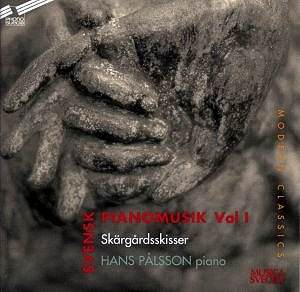Phono-Suecia's pilgrimage through the byways of Swedish
music has yielded up many treasures. This is the fifteenth disc in the
series issued between 1998 and 2003 at the rate of four per year. There
are two volumes anthologised from Swedish solo piano music during the
period 1910 to 1945. Both include music of conservative inclination
as well as pieces some which glance towards dissonant horizons. The
two discs (both reviewed on this site) are unusual in this series in
that they mix music by a range of composers rather than working on the
basis that predominates across Phono-Sueciae of one composer per disc.
Bjorkander, a Stockholm figure. He was not a
profuse producer. There is a Sonatina (1942), a concert fantasy (piano
and orchestra) and various suites: In Hemmar Hamlet and Glimtar
(Glimpses),both from 1946. The Four Archipelago Sketches
are variously joyous and unbridled, with tartly harmonised carillons,
dance figures and rain-drop reflections. Bjorkander can conjure an easy-flowing
dance in the spirit of Grieg. Several moments in this sequence are a
counterpart, though shorter-breathed, of John Foulds' April-England.
Sköld's slavonic Prelude and Fugue was
written in Brno. This is darker and rhapsodic music with a touch of
Gold's Exodus about the Prelude. Sköld wrote a great deal
including four symphonies and four string quartets. There are also three
piano concertos and two fantasies for piano and orchestra. The piece
featured here is dedicated to his teacher Wilém Kurz - that's
the same Kurz who made a performing edition of the Dvořák
Piano Concerto.
Beckman's five miniature 'blooms' are lightish
Macdowell-like pieces although sometimes, as in the fourth piece, The
Evening Hearth ... (tr. 10), there is a touch of the singing Medtner
about the themes. This composer, rather like Sillén (whose orchestral
music appeared on a Sterling CD last year) and Ives, was an insurance
broker. There is a symphony in F major (1895), a tone poem About
Happiness and a bipartite work for strings entitled Under Summer
Stars. Such titles!
Heintze wrote extensively for the piano. There
are four piano concertos and another for two pianos. In addition there
are some reportedly elegant chamber pieces, a piano quintet and trio,
and two violin concertos. The impromptu swings in the slowest of slow
motion. The Ballad is a major piece, Grieg-like but serious and rising
to an ecstatic release.
Liljefors' Andante e scherzo manages
to summon up images of rain-heavy clouds, a Siberian shiver in the air
and a wintry downpour. He also wrote a symphony (1943), sinfonietta
(1961) and violin concerto (1956). His father was Ruben, another composer
whose symphony has been recorded by Sterling.
Gottfried Berg has more of a reputation (at
least in Sweden) for sacred choral music. The four pieces entitled Wandering
are out of the same folk-naïf style as Peterson-Berger's Frösö
pieces and Bjorkander's marine pastels. These are fresh air pieces similar
to Moeran's Irish style. Wanderings take in some bleak and the
desolation of empty spaces.
Lastly Lennart Lundberg rounds out the generous
collection (a longer playing time than vol. 2) with a Nocturne
(clear-eyed and lissom) and a Toccata (shatter-cold and with
a Beethovenian blunt masculinity).
Phono Sueciae again directs light into the darker recesses
of Swedish music. So dark in fact that those who wondered at all probably
concluded there was nothing there worth illuminating. They were wrong.
Pålsson has all the requisite sympathy and technique
for these pieces. The recording quality tends to a warmth that slightly
clouds the middle register.
Rob Barnett

